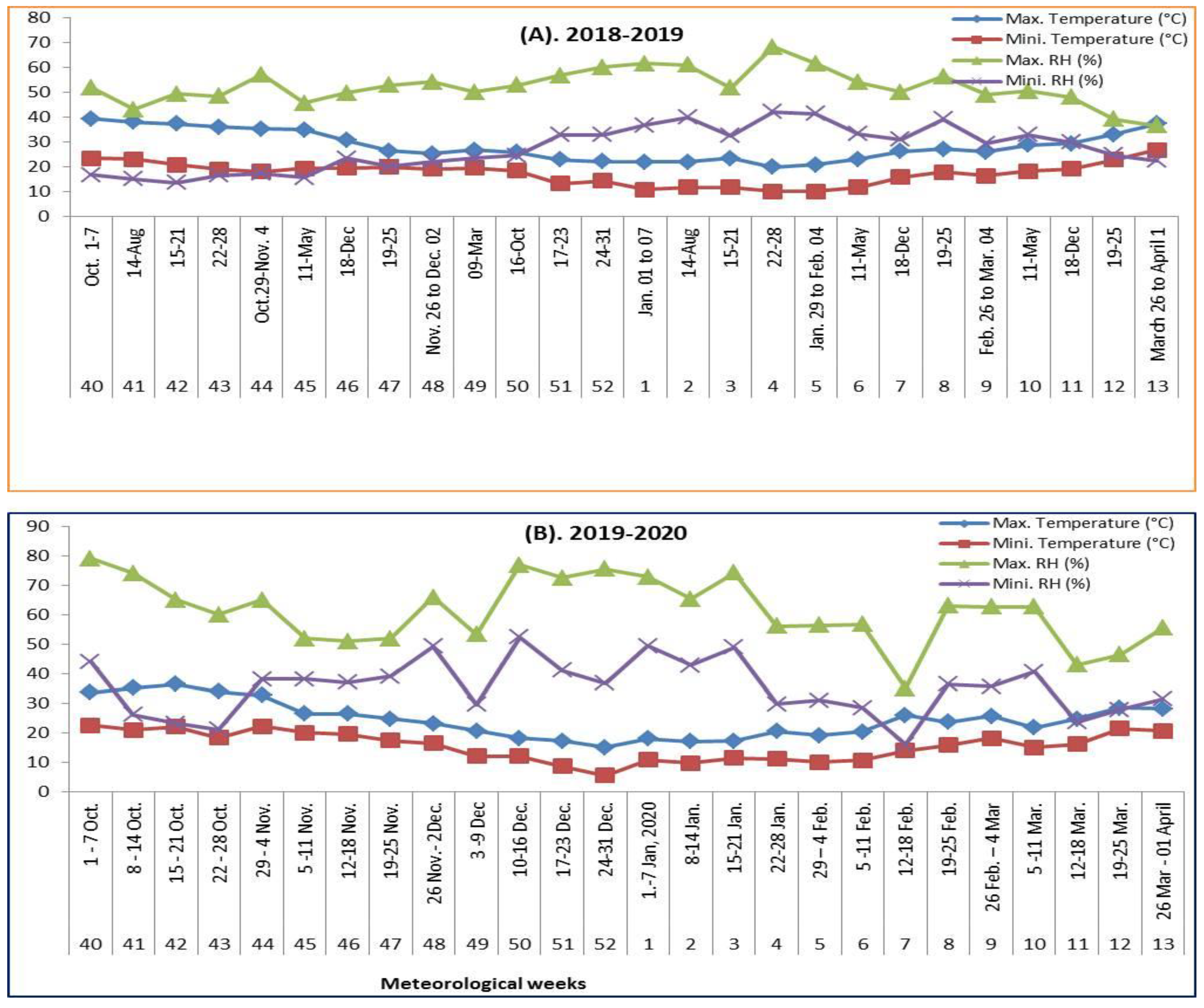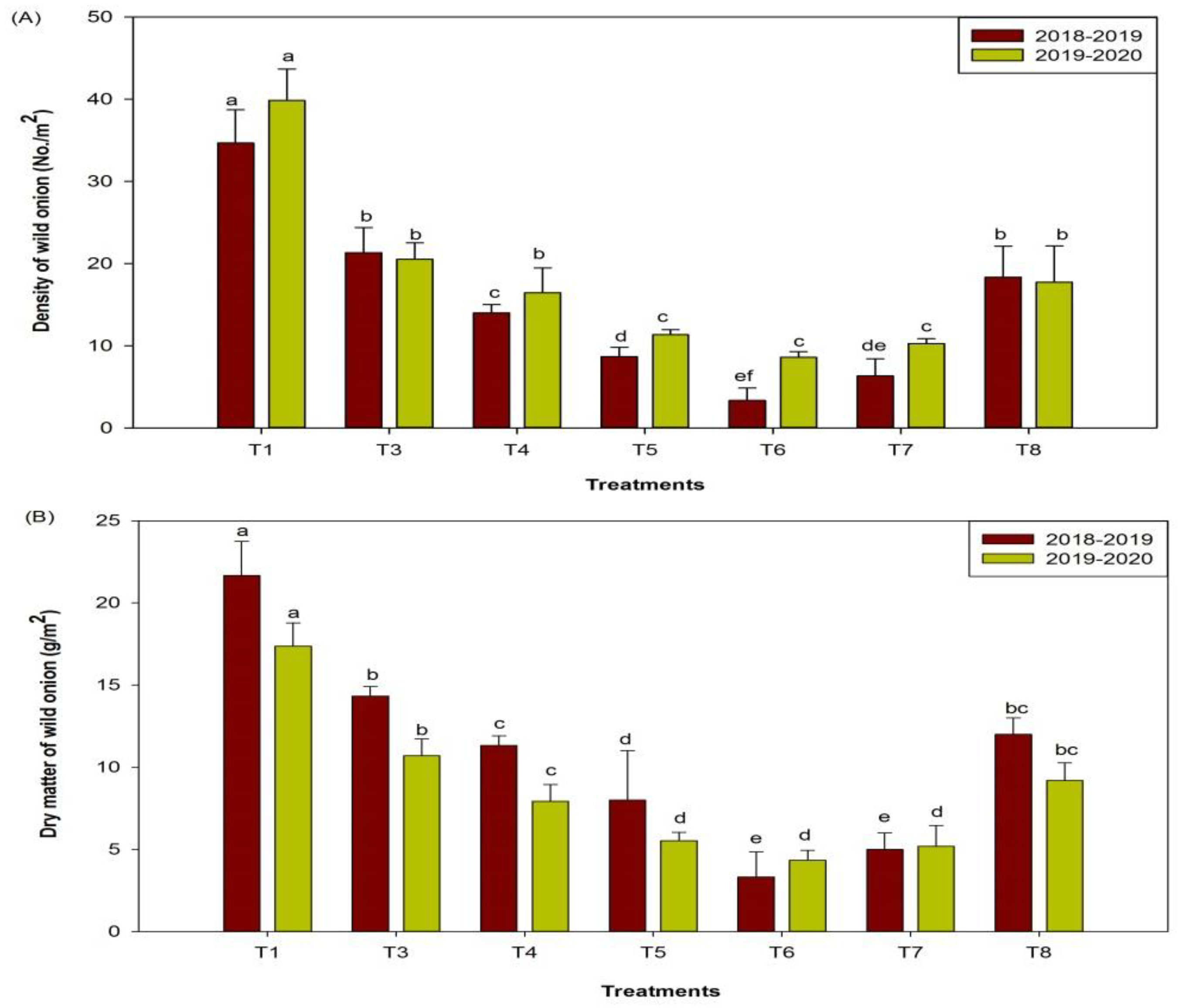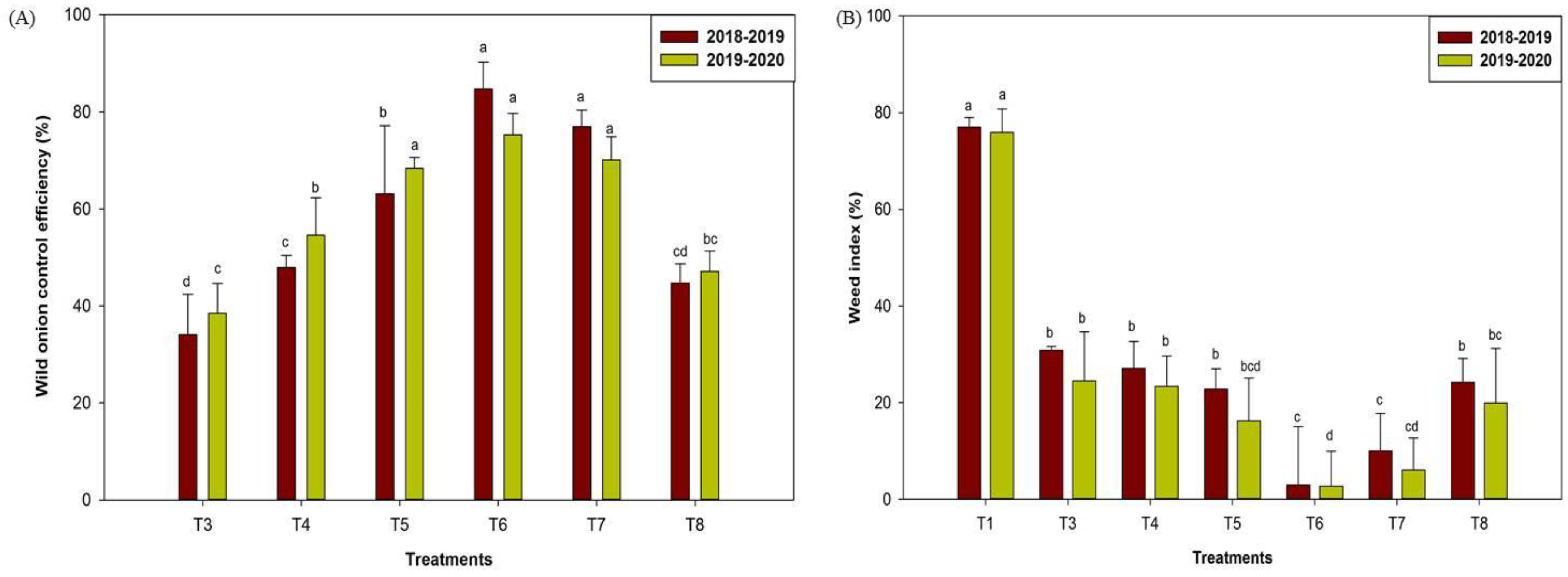Efficacy of Herbicides in Controlling Wild Onion (Asphodelus tenuifolius L.) in Cumin Grown under Arid Climatic Conditions
Abstract
:1. Introduction
2. Material and Methods
2.1. Field Experiment
2.2. Analysis of Weed Density and Weed Dry Weight
2.3. Analysis of Weed Control Efficiency and Weed Index
2.4. Analysis of Plant Growth, Yield, and Yield Attributes
2.5. Statistical Analyses
3. Results and Discussion
3.1. Major Weed Flora
3.2. Effect of Different Herbicides on Density and Dry Matter of Weeds
3.3. Weed Control Efficiency (WCE) and Weed Index (WI)
3.4. Effect of Herbicidal Weed Management on Cumin Plant Growth, Yield, and Yield Attributes
3.5. Economics
4. Conclusions
Supplementary Materials
Author Contributions
Funding
Institutional Review Board Statement
Informed Consent Statement
Data Availability Statement
Acknowledgments
Conflicts of Interest
References
- Dubey, P.N.; Saxena, S.N.; Mishra, B.K.; Solanki, R.K.; Vishal, M.K.; Singh, B.; Sharma, L.K.; John, S.; Agarwal, D.; Yogi, A. Preponderance of cumin (Cuminum cyminum L.) essential oil constituents across cumin growing agro-ecological sub regions, India. Ind. Crop. Prod. 2017, 95, 50–59. [Google Scholar] [CrossRef]
- Anonymous. Ministry of Agriculture-Jahad Statistics. 2020. Available online: https://www.maj.ir/Index.aspx?page_=form&lang=1&sub=65&tempname=amar&PageID=11583 (accessed on 18 February 2020).
- Moghaddam, M.; Miran, S.N.K.; Pirbalouti, A.G.; Mehdizadeh, L.; Ghaderi, Y. Variation in essential oil composition and antioxidant activity of cumin (Cuminum cyminum L.) fruits during stages of maturity. Ind. Crop. Prod. 2015, 70, 163–169. [Google Scholar] [CrossRef]
- Merah, O.; Sayed-Ahmad, B.; Talou, T.; Saad, Z.; Cerny, M.; Grivot, S.; Evon, P.; Hijazi, A. Biochemical composition of cumin seeds, and biorefining study. Biomolecules 2020, 10, 1054. [Google Scholar] [CrossRef]
- Patel, S.M.; Amin, A.U.; Patel, J.A. Effect of weed management practices on weed indices, yield and economics of cumin (Cuminum cyminum L.). Int. J. Seed Spices 2016, 6, 78–83. [Google Scholar]
- Yadav, R.S.; Dahama, A.K. Effect of planting date, irrigation and weed-control method on yield and water-use efficiency of cumin (Cuminum cyminum). Indian J. Agric. Sci. 2003, 73, 494–496. [Google Scholar]
- Singh, R.; Saxena, A. Weed dynamics and critical period of crop weed competition in cumin (Cuminum cyminum) under arid region of Rajasthan. J. Spices Aromat. Crop. 2013, 22, 165–169. [Google Scholar]
- Tewari, A.N.; Tiwari, S.N.; Rathi, J.P.S.; Verma, R.N.; Tripathi, A.K. Crop-weed competition studies in chickpea having Asphodelus tenuifolius dominated weed community under rainfed condition. Indian J. Weed Sci. 2001, 33, 198–199. [Google Scholar]
- Mishra, J.S.; Singh, V.P.; Yaduraju, N.T. Wild onion (Asphodelus tenuifolius Cav.) interference in lentil and chickpea crops and its management through competitive cropping. Weed Biol. Manag. 2006, 6, 151–156. [Google Scholar] [CrossRef]
- Yadav, R.P. Comparative efficacy of herbicides in controlling Asphodelus tenuifolius and other weeds in Indian mustard (Brassica juncea). Indian J. Agron. 1999, 44, 151–155. [Google Scholar]
- Mishra, J.S.; Swain, D.; Singh, V.P. Allelopathic effect of Asphodelus tenuifolius on wheat, mustard, lentil and chickpea. Pestology 2001, 25, 48–50. [Google Scholar]
- Hanif, Z.; Khan, M.I. Grassy weeds in chickpea (Cicer arietinum L.). Pak. J. Weed Sci. Res. 2004, 10, 139–144. [Google Scholar]
- Yaduraju, N.T.; Mishra, J.S. Zero-Tillage in rice–wheat cropping system on vertisols in Madhya Pradesh: Prospects and problems. In Proceedings of the International Workshop on Herbicide Resistance Management and Zero-Tillage in Rice-Wheat Cropping System, CCSHAU, Hisar, India, 4–6 March 2002; pp. 117–119. [Google Scholar]
- Mani, V.S.; Malla, M.L.; Gautam, K.C. Weed-killing chemicals in potato cultivation. Indian Farming 1973, 23, 17–18. [Google Scholar]
- Birla, L.; Naruka, I.S.; Shaktawat, R.P.S.; Ajnave, S.R. Integrated weed management in cumin. Indian J. Weed Sci. 2016, 48, 102–104. [Google Scholar] [CrossRef]
- Patel, R.B.D.; Meisuriya, M.I. Chemical weed control in cumin-pearl millet cropping system. Indian J. Weed Sci. 2008, 40, 44–45. [Google Scholar]
- Yadav, A.; Patel, J.C.; Mehta, R.S.; Meena, T. Growth, yield and economics of cumin (Cuminum cyminum L.) production as affected by weed management practices. Int. J. Seed Spices 2012, 2, 27–29. [Google Scholar]
- Mathukia, R.K.; Sagarka, B.K.; Panara, D.M.; Vekariya, S.J. Management of diverse weed flora of cumin by sole and combined herbicide application. J. Crop. Weed 2018, 14, 143–148. [Google Scholar]
- Mehdi, D.; Ebrahim, G.A.; Abbas, B.; Zeynab, O.; Meisam, H. Study the several herbicides effect on weeds control and yield of cumin (Cuminum cyminum L.). Iran. J. Weed Sci. 2018, 14, 83–95. [Google Scholar]
- Hassan, G.; Khan, I. Post emergence herbicidal control of Asphodelus tenuifolius in Desi chickpea (Cicer arietinum L.) at Lakki Marwat, Pakistan. Pak. J. Weed Sci. Res. 2007, 13, 33–38. [Google Scholar]
- Ross, M.A.; Childs, D.J. Herbicide Mode-of-Action Summary; Weed science: West Lafayette, IN, USA, 1995. [Google Scholar]
- Maxwell, K.; Johnson, G.N. Chlorophyll fluorescence—A practical guide. J. Exp. Bot. 2000, 51, 659–668. [Google Scholar] [CrossRef]
- Bhandari, V.; Singh, J.; Randhawa, J.S.; Randhawa, R.S. Studies on weed control in summer blackgram (Phaseolus mungo). Indian J. Weed Sci. 2004, 36, 129–130. [Google Scholar]
- Meena, S.S.; Kakani, R.K.; Mehta, R.S. Economic feasibility of weed management practices in cumin (Cuminum cyminum L.). J. Spices Aromat. Crops 2009, 18, 9–12. [Google Scholar]
- Rezaei, T.H.; Eslami, S.; Mahmoodi, S.; Moeini, M.M. Feasibility of chemical control of weeds in cumin (Cuminum cyminum L.). J. Plant Prot. 2020, 34, 457–472. [Google Scholar]



| Treatment | Branches/Plant | Plant Height (cm) | Umbels/Plant | |||
|---|---|---|---|---|---|---|
| 2018–2019 | 2019–2020 | 2018–2019 | 2019–2020 | 2018–2019 | 2019–2020 | |
| Weedy check | 4.0 ± 0.20 b | 3.90 ± 0.17 e | 21.0 ± 3.0 c | 20.1 ± 2.0 e | 15.4 ± 3.8 d | 15.7 ± 2.02 d |
| Weed free | 5.8 ± 0.52 a | 5.45 ± 0.30 a | 29.5 ± 1.7 a | 30.5 ± 0.80 a | 29.0 ± 2.0 a | 28.0 ± 1.32 a |
| Pendimethalin 38.7 CS @ 750 g/ha–PE | 4.4 ± 0.4 b | 4.30 ± 0.23 de | 25.0 ± 1.7 b | 24.7 ± 2.21 d | 20.9 ± 1.9 c | 20.0 ± 1.80 c |
| Oxyfluorfen @ 200 g/ha–PE | 4.5 ± 0.5 b | 4.53 ± 0.58 cd | 25 ± 2.65 b | 24.9 ± 1.53 cd | 21.3 ± 0.55 c | 21.7 ± 1.76 bc |
| Pendimethalin 38.7 CS 500 g/ha + oxyfluorfen 150 g/ha @–PE | 5.2 ± 0.20 a | 4.67 ± 0.11 cd | 27 ± 1.40 ab | 27.3 ± 1.47 bcd | 22.0 ± 1.58 c | 23.7 ± 0.77 b |
| Oxyfluorfen @ 200 g/ha 8 DAS–early POE | 5.7 ± 0.27 a | 5.20 ± 0.20 ab | 29.13 ± 0.80 a | 30.0 ± 1.47 ab | 28.0 ± 1.0 a | 27.2 ± 1.15 a |
| Pendimethalin 38.7 CS 500 g/ha + oxyfluorfen @ 150 g/ha 8 DAS–early POE | 5.6 ± 0.27 a | 4.93 ± 0.11 bc | 28.60 ± 0.91 a | 27.8 ± 1.75 abc | 26.0 ± 1.38 ab | 26.8 ± 2.52 a |
| Oxydiargyl @ 50 g/ha 20 DAS–POE | 4.5 ± 0.48 b | 4.60 ± 0.41 cd | 25.20 ± 2.31 b | 26.3 ± 2.13 cd | 22.7 ± 2.57 bc | 22.7 ± 1.60 bc |
| Treatment | Umbellates/Umbel | Seeds/Umbellate | Seed Yield (kg/ha) | |||
|---|---|---|---|---|---|---|
| 2018–2019 | 2019–2020 | 2018–2019 | 2019–2020 | 2018–2019 | 2019–2020 | |
| Weedy check | 4.2 ± 0.52 d | 3.7 ± 0.57 d | 4.03 ± 0.35 d | 3.6 ± 0.23 b | 103 ± 21 c | 91 ± 5 c |
| Weed free | 5.0 ± 2.0 a | 4.9 ± 0.11 a | 5.23 ± 0.40 a | 4.8 ± 0.20 a | 446 ± 19 a | 375 ± 16 a |
| Pendimethalin 38.7 CS @ 750 g/ha–PE | 4.4 ± 2.0 cd | 4.2 ± 0.20 c | 4.60 ± 0.20 c | 4.4 ± 0.20 a | 309 ± 13 b | 283 ± 28 b |
| Oxyfluorfen @ 200 g/ha–PE | 4.3 ± 0.10 cd | 4.4 ± 0.40 bc | 4.70 ± 0.26 bc | 4.5 ± 0.30 a | 325 ± 22 b | 287 ± 11 b |
| Pendimethalin 38.7 CS 500 g/ha + oxyfluorfen 150 g/ha @–PE | 4.7 ± 0.37 abc | 4.7 ± 0.26 abc | 4.90 ± 0.20 abc | 4.6 ± 0.20 a | 344 ± 6 b | 314 ± 21 b |
| Oxyflourfen @ 200 g/ha 8 DAS–early POE | 4.9 ± 0.36 ab | 4.8 ± 0.15 ab | 5.16 ± 0.15 ab | 4.8 ± 0.40 a | 433 ± 35 a | 365 ± 12 a |
| Pendimethalin 38.7 CS 500 g/ha + Oxyfluorfen @ 150 g/ha 8 DAS–early POE | 4.8 ± 0.20 abc | 4.8 ± 0.13 ab | 5.0 ± 0.20 abc | 4.7 ± 0.30 a | 402 ± 50 a | 353 ± 22 a |
| Oxydiargyl @ 50 g/ha 20 DAS–POE | 4.5 ± 0.20 bcd | 4.3 ± 0.30 bc | 4.63 ± 0.28 c | 4.5 ± 0.23 a | 338 ± 29 b | 301 ± 30 b |
| Treatments | Cost of Cultivation (USD/ha) | Gross Returns (USD/ha) | Net Returns (USD/ha) | B:C Ratio | |||
|---|---|---|---|---|---|---|---|
| 2018–2019 | 2019–2020 | 2018–2019 | 2019–2020 | 2018–2019 | 2019–2020 | ||
| Weedy check | 494.64 | 211.83 ± 43.5 c | 174.09 ± 10.0 c | −282.81 ± 43.5 c | −320.56 ± 10.0 d | 0.43 ± 0.08 d | 0.35 ± 0.02 e |
| Weed free | 585.67 | 919.44 ± 39.5 a | 721.78 ± 30.0 a | 333.77 ± 39.5 a | 136.11 ± 30.0 ab | 1.57 ± 0.07 a | 1.23 ± 0.05 abc |
| Pendimethalin 38.7 CS @ 750 g/ha–PE | 523.58 | 636.16 ± 26.6 b | 545.03 ± 53.0 b | 112.59 ± 26.6 b | 21.45 ± 53.0 c | 1.22 ± 0.05 c | 1.04 ± 0.10 d |
| Oxyfluorfen @ 200 g/ha–PE | 526.61 | 670.28 ± 45.7 b | 552.72 ± 21.7 b | 143.68 ± 45.7 b | 26.11 ± 21.7 c | 1.27 ± 0.087 c | 1.05 ± 0.04 d |
| Pendimethalin 38.7 CS 500 g/ha + oxyfluorfen 150 g/ha @–PE | 533.57 | 709.67 ± 12.42 b | 604.55 ± 40.1 b | 176.11 ± 12.42 b | 70.98 ± 40.1 bc | 1.33 ± 0.02 c | 1.13 ± 0.08 bcd |
| Oxyflourfen @ 200 g/ha 8 DAS–early POE | 526.61 | 893.10 ± 72.4 a | 702.34 ± 22.2 a | 366.49 ± 72.4 a | 175.72 ± 22.2 a | 1.70 ± 0.13 a | 1.33 ± 0.04 a |
| Pendimethalin 38.7 CS 500 g/ha + oxyfluorfen @ 150 g/ha 8 DAS–early POE | 544.49 | 827.84 ± 102.6 a | 678.81 ± 42.0 a | 283.35 ± 102.6 a | 134.32 ± 42.0 ab | 1.52 ± 0.18 ab | 1.25 ± 0.07 ab |
| Oxydiargyl @ 50 g/ha 20 DAS–POE | 518.84 | 697.31 ± 59.6 b | 578.36 ± 57.8 b | 178.47 ± 59.6 b | 59.52 ± 57.8 c | 1.34 ± 0.11 bc | 1.11 ± 0.11 bcd |
Publisher’s Note: MDPI stays neutral with regard to jurisdictional claims in published maps and institutional affiliations. |
© 2021 by the authors. Licensee MDPI, Basel, Switzerland. This article is an open access article distributed under the terms and conditions of the Creative Commons Attribution (CC BY) license (https://creativecommons.org/licenses/by/4.0/).
Share and Cite
Mehriya, M.L.; Geat, N.; Kumhar, S.R.; Alrajhi, A.A.; Alkuriji, M.A.; Dewidar, A.Z.; Mattar, M.A. Efficacy of Herbicides in Controlling Wild Onion (Asphodelus tenuifolius L.) in Cumin Grown under Arid Climatic Conditions. Agronomy 2021, 11, 1597. https://doi.org/10.3390/agronomy11081597
Mehriya ML, Geat N, Kumhar SR, Alrajhi AA, Alkuriji MA, Dewidar AZ, Mattar MA. Efficacy of Herbicides in Controlling Wild Onion (Asphodelus tenuifolius L.) in Cumin Grown under Arid Climatic Conditions. Agronomy. 2021; 11(8):1597. https://doi.org/10.3390/agronomy11081597
Chicago/Turabian StyleMehriya, Moti Lal, Neelam Geat, Sita Ram Kumhar, Abdullah A. Alrajhi, Mohammed A. Alkuriji, Ahmed Z. Dewidar, and Mohamed A. Mattar. 2021. "Efficacy of Herbicides in Controlling Wild Onion (Asphodelus tenuifolius L.) in Cumin Grown under Arid Climatic Conditions" Agronomy 11, no. 8: 1597. https://doi.org/10.3390/agronomy11081597
APA StyleMehriya, M. L., Geat, N., Kumhar, S. R., Alrajhi, A. A., Alkuriji, M. A., Dewidar, A. Z., & Mattar, M. A. (2021). Efficacy of Herbicides in Controlling Wild Onion (Asphodelus tenuifolius L.) in Cumin Grown under Arid Climatic Conditions. Agronomy, 11(8), 1597. https://doi.org/10.3390/agronomy11081597






